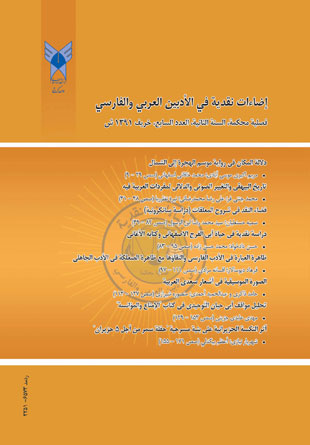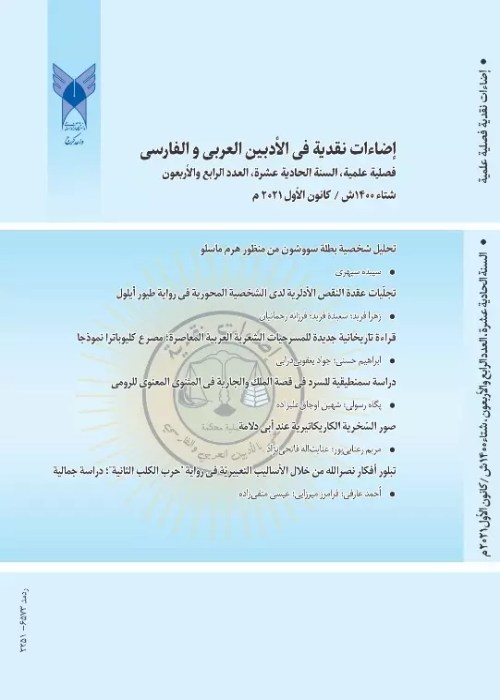فهرست مطالب

فصلنامه إضاءات نقدیه فی الادبین العربی و الفارسی
پیاپی 7 (خریف 2012)
- تاریخ انتشار: 1391/09/15
- تعداد عناوین: 8
-
-
صفحات 9-29
-
صفحات 49-82
-
صفحات 113-127
-
Pages 9-29Place receives a paramount importance in the novel, not because it is an element in the story, or it is the context in which events occur or characters move in it, but because in some outstanding works it becomes a space which encompasses all of the storie's elements, including events and characters, and covers their inner relationship. When the place finds a way into the story, it achieves Ideological or Psychological meaning. It is possible to analyze the novel via exploring the meaning of the place. The setting includes objects, colors, sounds, odors, and these show character's emotions and thoughts. Place in the novel Season of Migration to the North consists of room, village and home. Place in this novel has Ideological meaning, because it shows the identity.Keywords: Season of Migration to the North, Novel, setting, Tayyib Salih
-
Pages 31-48The fifth century (lunar calendar) is considered significant in the matters of historical aspects. It is the time in which dependent governments rose and little by little tried to free themselves from Arab governance. But it meant that governance of Turks and Mongols were arriving. At that unsteady time that the political Iranian governments were facing, the historians were obliged to hold another responsibility and among them, Abolfazl Bayhaqi rose with his famous history so-called History of Beihaghi and he is at the top ranking.Presence of a body such as Risalat (Commission) and Clerical office implies that the social and administrative layers. Bayhaqi not only tried to use Arabic language just for public and conscious aspects of usage but because of his language environment he had to use Arabic language in all language levels, inevitably. Study of History of Bayhaqi by itself and also regarding such social and cultural circumstances in brief are all the factors clearing this issue. But beside this unconscious use which is considered as that era’s language suitability, Bayhaqi himself who was a great Arabic knower and well-grounded clerk has used the proverbs, poems and narrations at their place.Keywords: Bayhaqi, History of Bayhaqi
-
Pages 49-82Considering the importance of Muallaqat in Arabic literature, as well as its importance in the various sciences of language, literature, grammar and also containing many of the Jahelliah words a great number of commentators paid attention to them. In the present study, it is intended to study the critical method of commentators in their explanations of the Muallaqat, descriptive - analytical method being employed.The results of the study reveals that commentators paid attention to criticism although it isn’t much. And their critical views are focused on technical levels (Dictionary, phonetics, syntax, rhetoric) and semantic level.Keywords: Muallaqat, explanations, criticism, synchronization, Discourse
-
Pages 83-95Abu-al-Faraj Isfahani is deemed among the most outstanding thinkers of the third century, who has been also an authority in disciplines such as geneology.In this essay we have regarded his scholarly as well as literary biography and we have studied the ambiguities in his personality. Then we have deconstructed his book Alghani and have criticized some aspects of it. Apart from what the opponents and proponents have claimed concerning Isfahani's character, many scholars have confessed his literary and scientific rank, and Alghani is regarded as a literary and historical encyclopedia since inside the book, one can find the biography of many of the Jaheli, Islamic, and Abbasi era poets all of which can be viewed as a reliable source to the researchers.Keywords: Isfahani, Alghani
-
Pages 97-111We can see a special phenomenon in Islamic era which has been called Ayari. This phenomenon can be compared to Saalouk in Pre-Islamic era. Both of these phenomena (Ayari and Saalouk) have common purposes in order to help other people especially the helpless and produce justice in society. In fact, the literature of Ayari, is same as proletariat literature versus capitalist's literature which is very simple and there is not any artifice and craft in it. Usually we know Ayaran as a symbol of plunderer and theft for the struggle against poverty, deprivation and begging. Also, they stand up against racial privileges, class privileges and freedom because they are the ones who are generous, self-sacrificial and courageous.Keywords: Ayari, Saalouk, literature of Ayari, Pre, Islamic era
-
Pages 113-127
The essence and the beauty of a poem relies heavily on elements such as music. Music covers a wide area which is truly grasped and applied by masters of rhetoric. Sadi is also considered as one of the greatest Persian poets who has depicted his unique talent in this field. Sadi's poetry is genuinely musical. There have been some researches conducted in this respect. However, one feels the need to focus on his Arabic composition also. This research has focused on various levels of musicality in Sadi's poetry. After some introductory notes on poetry and the music of poetry, the researcher has focused on different levels of music in his Arabic poetry. Kolliyate Sadi by Abaha-ol-Dine Khorramshahi is used as the primary source of Arabic poems.
Keywords: Sadi, music, Arabic compositions -
Pages 129-153Al emta wa al Moanesat is like its name, interesting, and throwing light on Iraq at the second half of fourth century, namely “al Bowayhee age”, that is marked with darkness. This book discusses a lot of social problems, and portrays sovereigns and ministers and their meeting and merits and evils, and portrays the ulema and analyzes their character, and the conversations among them.Aboohayan’s custom in this book, is that “ebn Sadan” asks and “Aboohayan” replies, sometimes making question on him, respiting him until tomorrow or some unknown time, so that he can read and make debate with others to answer him orally or written.“Ebne sadan” doesn’t confine himself to hearing, rather he partakes in discussion and concurs or refuses. Al emta wa al Moanesat portrays upper classes, how they discuss, think, and portrays this life in a fictional guise divided into nights. But uses less fancy and imagination in comparison to One Thousand and One Night.Keywords: Al emta wa al Moanesat”, Abbassid society, Aboohayan al towhid
-
Pages 155-171Failure (defeat) has a very clear effect in the Arab’s drama history. After Hazyran, scriptwriters and playwrights tried to use the subject of failure in their works and also they tried to stem it and analyzed the causes and consequences of it for the community. Therefore, they sought after new styles and new dramatic approaches to portray overwhelming disaster in 1967.The failure in the 5th Hazyran (June) as an important historical event, shakes Venus deeply from inside. He decided to find a new structure for drawing this vicissitudinous course (period).His activities and measures for application of the proper structure of plays and script are useful and valuable and for this wondrous event presented a new form and structure. Meanwhile, he took advantage from new theatrical forms and approaches in the world and its achievements and result.The structure that Venus presented in the “soiree for the 5th Hazyran” script is a new chapter in the drama history of Syria.Keywords: Sadollah Venus, Script (play), Soiree for the 5th Hazyran, structure of script


